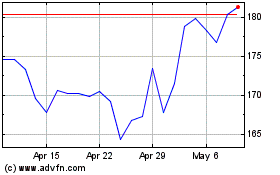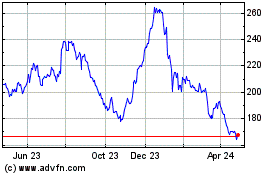Boeing Considers Ending Production Of Iconic 747
July 27 2016 - 3:57PM
Dow Jones News
By Jon Ostrower
The world's most iconic airplane is coming in for a landing.
Boeing Co. said in a regulatory filing Wednesday that it may
stop production of the 747, ending nearly a half-century of
producing the plane that became the aircraft of choice for the U.S.
president and other heads of state.
The prospect of ending 747 production after years of weak sales
would close a chapter of Boeing's history that began when the
humped jetliner won its first orders from Pan American World
Airways five decades ago.
Boeing has delivered more than 1,500 of the jets since 1970 and
it is credited by historians with also making global air travel
more affordable for most people. The huge number of seats,
sometimes nearly 600 on some airlines, spread the costs across the
large group of paying passengers.
The 747 has weathered industry downturns over the decades,
including when Boeing nearly went out of business in the 1970s. The
747 has been a constant for the plane maker and was a hallmark of
the U.S.'s Cold War industrial prowess.
But Boeing currently plans to make just six of the planes a year
starting in September, including two expected to serve the U.S.
president, known as Air Force One from 2023 after years of
modifications. A pair of older 747s in their distinctive white,
blue and polished aluminum have been flying the U.S. presidents
since 1990. Boeing's production of the aircraft last peaked at 70
in 1990 after fluctuating from a high of 92 in 1970.
Air cargo has also experienced a sharp slowdown since the 2008
global financial crisis as freight is traveling by sea or in the
bellies of passenger aircraft. In its passenger-carrying form, the
747 has faltered as airlines have preferred smaller twin-engine
jets. Rival Airbus Group SE is slashing production of its own
even-larger double-deck jumbo in 2018.
New jets still roll off Boeing's assembly line in Everett, Wash.
today as its 747-8. But last week, Boeing announced a $1.2 billion
charge on the program and curtailed plans to raise 747 output back
to one jet a month in 2019.
Mr. Muilenburg said that the charge reduces the future financial
risk of the 747 to Boeing, which hasn't contributed positively to
its earnings for years. Boeing believes that 2019 could bring a
wave of retirements of older jets that could be replaced by
factory-fresh 747s.
It has been a bumpy first year on the job for Boeing's new Chief
Executive, Dennis Muilenburg. Shares have fallen roughly 3.5% since
Mr. Muilenburg t ook over the top spot in July 2015. A decision
about the jumbo jet's future will likely fall to Mr. Muilenburg,
who was just two years old when Boeing started taking orders for
the plane
Boeing on Wednesday reported its first quarterly loss in nearly
seven years, from a total of $3 billion of charges, including for
the 747.
The other charges stem from delays to the Boeing's advanced 787
Dreamliner and the company's new aerial refueling tanker. They were
largely expected, but underscore the challenges still facing some
crucial projects.
The Dreamliner program has been the most costly for Boeing over
the years, with the company forced to spend tens of billions of
dollars more than first anticipated, with the latest bill for
production at $27.7 billion.
The company said it would begin to make money on each 787
delivery by the end of the year but only after having built around
500 aircraft since 2011, or around 40% of its orders.
Boeing reported a loss of $234 million, or 37 cents a share,
compared with a year-earlier profit of $1.1 billion, or $1.59 a
share, a year earlier. Revenue rose 1% to $24.8 billion.
However some metrics managed to beat analyst expectations.
Adjusted "core earnings" loss, which excludes certain pension
expenses and is closely watched by the market, came in better than
expected, helping to lift Boeing shares 1.9% at $137.88 in midday
trading.
On Wednesday, the company revised its annual earnings per share
guidance to $6.40 to $6.60, from a range of $8.45 to $8.65 per
share. It left its closely watched cash flow guidance unchanged at
roughly $10 billion.
As older development programs continue to weigh on its finances,
Boeing's aerial tanker, its biggest defense program, pushed more
than 40% past its original budget.
Boeing added $243 million to its development bill in the first
quarter in an effort to keep the program on schedule, only to add
$573 million more from new delays with its most recent charge. The
company announced in May that first deliveries to the U.S. Air
Force were stalled by five months due to design and production
issues.
Boeing last week completed early aerial trials refueling
aircraft from the U.S. Air Force, Navy and Marines, clearing the
way for a purchase decision in August by the Defense Department.
The company still faces a battery of tests to complete the tanker
over the next year.
--Doug Cameron contributed to this article
Write to Jon Ostrower at jon.ostrower@wsj.com
(END) Dow Jones Newswires
July 27, 2016 15:42 ET (19:42 GMT)
Copyright (c) 2016 Dow Jones & Company, Inc.
Boeing (NYSE:BA)
Historical Stock Chart
From Aug 2024 to Sep 2024

Boeing (NYSE:BA)
Historical Stock Chart
From Sep 2023 to Sep 2024
